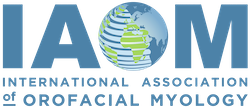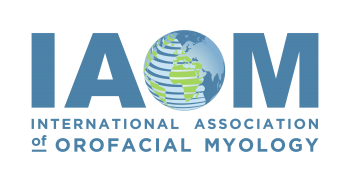Position statement of the IAOM regarding appliance use for the Oral Habit Patterns.
Prepared by:
Robert M. Mason, DMD, PhD
Honor Franklin, PhD
BACKGROUND: Some orthodontists and others in dentistry continue to address oral habit patterns with appliances involving cribs, rakes, spikes, prongs or other tongue reminders. By contrast, procedures utilized by orofacial myologists are effective in modifying oral habit patterns without the need for appliances.
NEGATIVE ASPECTS OF HABIT APPLIANCES:
- Most habit appliances are designed to block a tongue thrust (swallow) rather than to modify the rest posture of the tongue and address the problem of inability to close the lips.
- Habit appliances attempt to prevent a tongue thrust swallow. They neither teach the tongue where it should rest, nor teach a correct nasal breathing rest posture.
- Habit appliances do not address the cause of the oral habit pattern. Unresolved airway issues or prolonged sucking habits are the usual reasons for a retained tongue thrust or forward, interdental rest posture of the tongue.
- Habit appliances, by virtue of cribs, rakes, spikes, prongs or other vertical components, serve to open the dental freeway space. This encourages a differential eruption of teeth in the mixed dentition by accelerating posterior dental eruption and vertical drift while impeding the normal eruption of anterior teeth. The consequence of this can worsen rather than correct the malocclusion and further exacerbate lip incompetence.
- Clinically observed patient adaptations to habit appliances include eating and speaking problems, the development of a lateral tongue thrust and even lateral open bites. Some patients are seen to adapt by positioning their tongue under the appliance, thus increasing the vertical freeway space dimension, leading to further posterior eruption and lip incompetence.
- When a habit appliance is removed and the cause of the tongue pattern is not addressed, the forward tongue posture and functions are expected to return.
PERSPECTIVES ABOUT ORAL HABIT PATTERNS AND THE ROLE OF OROFACIAL MYOLOGY
- In our view, and as well established in dental science, the rest posture of the tongue is linked to the development of malocclusions, especially anterior open bite, while tongue thrusting is viewed as an adaptation to, rather than a primary cause of a developing malocclusion.
- Orofacial myofunctional therapy isrest posture therapy:orofacial myofunctional therapy procedures are designed to normalize the rest posture of the tongue and lips. Working to eliminate a tongue thrust swallow is a secondary but important aspect of therapy.
- A primary goal of orofacial myofunctional therapy is to establish or recapture a normal freeway space dimension. In our view, a normal interocclusal rest position is key to normal dental eruption and creating stability of the dentition. An excessive freeway space beyond the normal range of 2-3 mm posteriorly, is a characteristic of many patients with oral habit patterns.
- Other oral habit patterns, such as a mouth-open lips-apart posture, lip biting, clenching and grinding, and sucking habits, respond well to treatment without the use of appliances. Thumb and finger sucking habits respond well to behavioral modification. Appliances are never recommended by us for thumb and finger sucking habits.
- For patients with a tongue thrust and thumb sucking habit, the tongue thrust will remain as long as there is a sucking habit.
- Therapy to modify tongue rest posture or functions will not be successful until any associated airway issues are resolved.
SOME SELECTED REFERENCES/BACKGROUND STUDIES/CLASSIC ARTICLES RELATED TO OROFACIAL MYOFUNCTIONAL PERSPECTIVES:
RECOMMENDED REFERENCE TEXTS
Enlow, D.H., and Hans, M.G.:Essentials of Facial Growth, W.B. Saunders, Philadelphia, 1996.
Hanson, M.L., and Mason, R.M.:Orofacial Myology: International Perspectives, C.C. Thomas, Springfield, IL, 2003.
Proffit, W.R., Sarver, D.M., and Fields, H. W.:Contemporary Orthodontics,4thEdition, C.V. Mosby, St. Louis, 2006.
Sicher, H., and DuBrul, E.L.:Oral Anatomy,5thEdition, C.V. Mosby, 1970.
PRESSURE TRANSDUCER STUDIES.
Mason, R.M., and Proffit, W.R.: The tongue thrust controversy: Background and recommendations.J. Speech Hearing Disorders, 39, 2, 1974, 115-132.
Proffit, W.R.: Lingual pressure patterns in the transition from tongue thrust to adult swallowing.Arch. Oral Biol.,17, 1972, 555-563.
Proffit, W.R., Chastain, B., and Norton, L.: Linguo-palatal pressures in children.Am. J. Orthodontics,55, 1969, 154-166.
Proffit, W.R.: Muscle pressure and tooth position: A review of current research.Australian Orthodont., 3, 1973, 104-108.
Proffit, W.R., and Norton, L.: The tongue and oral morphology: Influences of tongue activity during speech and swallowing. InSpeech and the Dentofacial Complex: The State of the Art, ASHA Reports 5.American Speech and Hearing Association, Washington D.C., 1970, 106-115.
Proffit, W.R., and Mason, R.M.: Myofunctional therapy for tongue-thrusting: background and recommendations.J. Am. Dental Assoc.,90, February, 1975, 403-411.
Proffit, W.R.: Equilibrium theory revisited: Factors influencing position of the teeth.Angle Orthod.48, 3, 1978, 175-186.
ORAL HABITS
Norton, L.A., and Gellin, M.E.: Management of digital sucking and tongue thrusting in children.Dental Clinics of North America,July, 1968, 363-382.
Nowak, A.J., and Warren, J.J.: Infant oral health and oral habits.Pediatric Clinics of North America,47, 2000, 1043-1065.
GROWTH AND DEVELOPMENT/MORPHOLOGY
Ingervall, B., and Eliasson, G.B.: Effect of lip training in children with short upper lip.Angle Orthod.,52, 3, 1982, 222-233.
Mason, R.M., and Serafin, D.: The tongue: Interdisciplinary considerations. Chapter 38, in Serafin, D., and Georgiade, N.G:Pediatric Plastic Surgery,volume 2, C.V. Mosby, St. Louis, 1984, 711-732.
Satomi, M.: The relationship of lip strength and lip sealing in MFT.Int. J. Orofacial Myology,27, 2001, 18-23.

